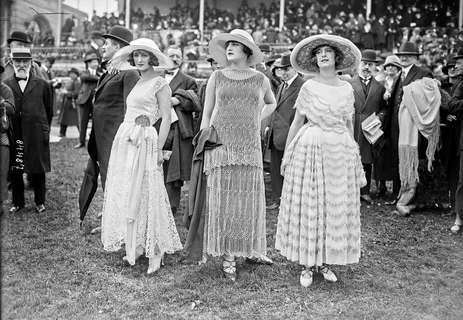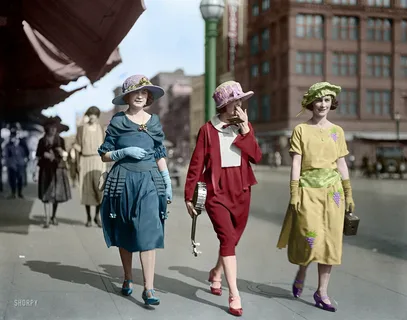1923 was a defining moment in women’s fashion. The Roaring Twenties were in full swing, and along with jazz music and flapper culture, fashion was undergoing a revolutionary transformation. 1923 Women’s Fashion was not just about clothing, but about freedom, identity, and breaking free from the constraints of the past. Let’s dive into the trends that shaped women’s fashion during this iconic year.
The Shift Towards Simplicity and Freedom

The early 1920s were a time of great change for women. The aftermath of World War I saw women stepping out of traditional domestic roles and into the workforce. This shift had a profound impact on 1923 Women’s Fashion, as practicality and comfort became central to everyday wear. The restrictive, heavy dresses of the previous decades were replaced by more straightforward, relaxed designs.
In 1923, women’s fashion embraced freedom in more ways than one. Dresses became shorter, typically reaching just below the knee, and waistlines dropped, often sitting around the hips. These changes created a more casual, androgynous look, freeing women from the tight corsets and structured silhouettes that had dominated earlier eras. The keyword “1923 women’s fashion” is reflected in this shift, showing how the style of the time aligned with women’s changing roles in society.
Flapper Fashion: Bold and Rebellious
No discussion of 1923 women’s fashion would be complete without mentioning the iconic flapper look. The flapper style was bold, daring, and reflective of the growing sense of liberation among 1923 Women’s Fashion. Flapper dresses, which were often sleeveless or featured short sleeves, were straight and loose, allowing for easy movement. They were decorated with beads, sequins, and fringe, making them perfect for dancing, a popular activity in the jazz-fueled nightclubs of the era.
Flapper fashion also embraced short haircuts, with the bob becoming the hairstyle of choice for many women. This look symbolized a break from tradition and represented a newfound sense of independence. For the modern US audience, the flapper is often seen as the quintessential image of 1920s women’s fashion, and in 1923, this style was at its peak.
Fabrics and Patterns of 1923
While simplicity was the order of the day, that didn’t mean 1923 women’s fashion was boring. Women embraced bold fabrics and patterns, often incorporating geometric designs, Art Deco influences, and rich colors like deep blues, greens, and reds. Silks, satins, and velvets were popular choices for evening wear, while day dresses were often made from lighter materials like cotton or linen.
These fabrics were chosen for their draping qualities, which complemented the looser, flowing silhouettes of the time. Women of 1923 wanted their clothes to reflect their active lifestyles and to allow freedom of movement, which is why materials that could flow and move with the body were in such high demand.
Accessories: Hats, Jewelry, and Shoes
Accessories were a significant part of women’s fashion in 1923. Cloche hats, characterized by their close-fitting, bell-shaped design, were a must-have. These hats were often adorned with ribbons or brooches, adding a touch of flair to any outfit.
Jewelry in 1923 followed the trends of the time, with long strands of pearls, layered necklaces, and bold, chunky bracelets becoming popular. The influence of Art Deco could be seen in jewelry designs, with sharp lines, geometric shapes, and the use of materials like onyx and jade.
Shoes also underwent a transformation in the 1920s. The Mary Jane shoe, with its low heel and strap across the instep, was a popular choice. Women of the time favored shoes that were stylish yet comfortable, which aligned with the overall trend of practicality and ease.
1923 Women’s Fashion and the Role of Hollywood
Hollywood played a massive role in shaping the fashion trends of 1923. Silent film stars like Clara Bow and Louise Brooks became style icons, and women across the US sought to emulate their looks. The rise of cinema meant that fashion was no longer confined to the wealthy elite; women everywhere could see the latest styles on screen and incorporate them into their own wardrobes.
This democratization of fashion was a significant development in the 1920s. Movie stars, with their glamorous dresses and daring hairstyles, brought the trends of Paris and New York to small towns across America. In this way, 1923 women’s fashion was influenced not just by designers, but by the entertainment industry as well.
The Evolution of Underwear: Freedom from the Corset
A significant aspect of 1923 women’s fashion was the evolution of underwear. Women had been confined to tight corsets for centuries, but by 1923, the corset was largely a thing of the past. Instead, women wore loose-fitting undergarments like chemises and step-in panties, which allowed for greater comfort and freedom of movement.
The new silhouette of the 1920s did not require the extreme waist-cinching of previous eras. The boyish, straight lines of 1923 dresses called for less structure, and women embraced this newfound freedom with enthusiasm.
Evening Wear in 1923
While daytime fashion focused on simplicity and comfort, evening wear in 1923 was all about glamour. Women wore elegant gowns made from luxurious fabrics like satin and velvet, often adorned with beads, sequins, and fringe. These gowns were typically sleeveless or featured delicate straps, allowing women to show off their arms and shoulders.
Evening dresses were also shorter than in previous decades, often ending just below the knee. This was a significant departure from the floor-length gowns of earlier eras and reflected the more relaxed, playful attitude of the time.
The Impact of 1923 Women’s Fashion on Today’s Style

The fashion trends of 1923 continue to influence modern women’s fashion. The loose, relaxed silhouettes of the 1920s paved the way for the casual styles that dominate today’s wardrobes. The emphasis on comfort, practicality, and personal expression is as relevant now as it was in 1923.
Flapper-inspired dresses, with their fringe, sequins, and playful designs, often make a comeback in modern evening wear, especially during themed parties or fashion collections that draw inspiration from the Roaring Twenties. The cloche hat, bobbed hair, and pearls remain iconic symbols of 1920s fashion, still referenced in fashion circles today.
FAQs About 1923 Women’s Fashion
Q: What was the defining feature of 1923 women’s fashion?
A: The defining feature of 1923 women’s fashion was the shift towards simpler, more practical clothing. Dresses were looser and shorter, and the restrictive corsets of the past were replaced by more comfortable undergarments.
Q: How did the flapper style influence 1923 fashion?
A: The flapper style was a significant influence in 1923. It introduced a more androgynous, carefree look, with shorter hemlines, looser silhouettes, and bold accessories like long pearls and cloche hats.
Q: What fabrics were popular in 1923 women’s fashion?
A: Fabrics like silk, satin, velvet, and cotton were popular in 1923, chosen for their draping qualities and comfort. Evening wear often featured luxurious materials like silk and velvet, while daywear focused on lighter fabrics.
Q: How did Hollywood influence fashion in 1923?
A: Hollywood played a huge role in shaping fashion in 1923. Film stars became style icons, and women across the US looked to them for inspiration, adopting the latest trends seen on the silver screen.
In conclusion, 1923 was a pivotal year in women’s fashion, representing a break from the past and a move towards freedom, practicality, and personal expression. From the iconic flapper dresses to the democratization of fashion through Hollywood, the trends of 1923 continue to resonate today.
Read more: womenfashionwear.site

